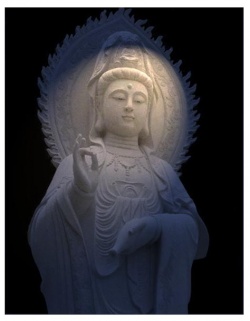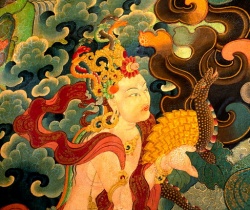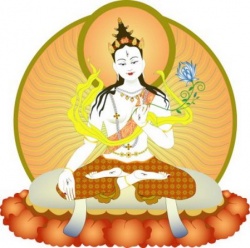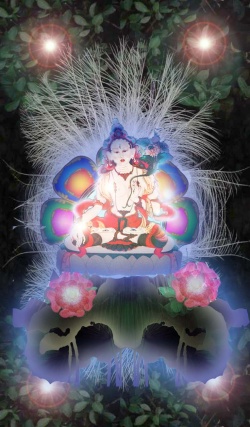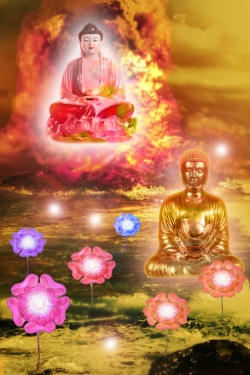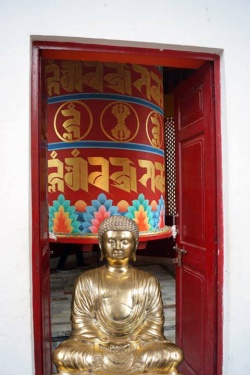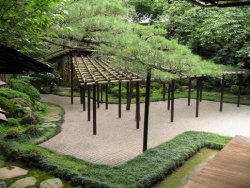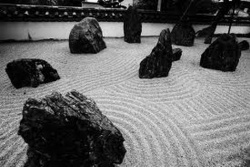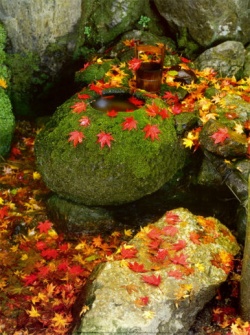Now For Some Teachings on Zen
So we learned about (1)what it means to "see the tao", (2) sexual cultivation and all the misconceptions today surrounding this topic, then (3) the anapana method in the Anapanasati Sutra for cultivating outstanding gong-fu, then (4) how to use yogic tantra to open up the central channel. Now for (5) Zen.
In The Story of Chinese Zen, and Basic Buddhism, Master Nan corrects many of the strange academic notions about Zen prevalent today. You can also find such insights in Working Towards Enlightenment and To Realize Enlightenment. You can find printed copies of these books on the internet now and then. Amazon.com still sells them.
The idea I hate the most, aside from the fact that Zen is some sort of flippant mind game or clash of witty remarks, is that Zen is some sort of intellectual mental thought realization — so many writers and academics miss the point entirely that the great Zen masters were cultivating samadhi dhyana along the way to enlightenment and achieved high states of attendant gong-fu, as just mentioned, but ignored them or wrote about them in only a few short lines.
It was considered a great breach of Buddhist discipline to become attached to body gong-fu or to demonstrate superpowers, so masters only demonstrated it once or twice (if at all) before they were ready to die.
The higher their stage, the more closely they held to the rules of discipline in this regard. For instance, if you constantly demonstrated superpowers, people would mistake this for the path, FOR SURE.
As a result, academics miss the cultivation picture entirely. You can see this idea corrected in Working Towards Enlightenment and To Realize Enlightenment, but you will hardly find a single writer on Zen or Buddhism today who references any of these books that correct the mistaken notions.
It always makes me laugh to open up the bibliography of the popular spiritual / cultivation books today and to see what other books were referenced in the bibliography in the back, and you will almost always see the real cultivation books missing. Just nonsense books referencing other nonsense books that lack any real cultivation content.
But of course, nonsense is what sells — cultivation involves work and that’s just too hard, and the target too lofty. It’s what you’re supposed to be after when you decide to go to the Church, temple or mosque every week, but ceremonial attendance is a lot harder than trying to transform yourself, isn’t it? So who wants to do that, and which set of religious functionaries would dare risk their income flows expounding the true way that hardly attracts anyone?
Go ahead and start flipping through bibliographies to see for yourself who cites whom, and then step back to ponder why.
I have previously mentioned several really great Christian cultivation books that recount the gong-fu of Christian monks who cultivated very well, and the same for Jewish kaballah, and you will not find such GOOD books cited anywhere. The establishment ignores these, but these are the saints of those traditions.
Why is it that this type of book, of the real cultivation exploits of the adherents in their own tradition, ignored (and it’s not because their stories and gong-fu results match the path results of adherents in other traditions because people don’t even think that hard)?
I’m tired of writing about it — you figure it out yourself this time. I’ve told you the principle over and over again.
Back to the Zen way to cultivate. As to Zen, the Diamond Sutra of Buddhism opens with Subhuti asking Buddha how to achieve enlightenment.
The passage is usually translated incorrectly because the translators don’t know the Zen method themselves, but in a loose translation it has Buddha saying that that very moment anyone wants the Tao it’s already there (THIS moment is IT!)– the true mind is already calm, open, clean, it’s there. (Why?
Because we are always using this clean omnipresent perception, we are always in it but just misuse it. You are using it this very instant but don’t realize it.)
Subhuti responds that he understands this, but ordinary people do not, so please Buddha do speak more.
And then the Buddha goes into a long lecture on cultivation and performing merit to get the Tao because people don’t understand the quick Zen way of directly achieving the Tao in one moment, this very moment. That’s the Zen way of no method, no effort.
In the Surangama sutra, Shakyamuni Buddha also talks about the quick Zen way to realization, but then also talks about cultivating samadhi and all sorts of other topics.
You have to search for the quote to find that he talks about how to directly cultivate the true mind to reveal it, to see it, to perceive it, to attain self-realization and see the Tao, gain the Tao, become enlightened.
Then he says the next best way is to cultivate samadhi as a stepping stone. In the Complete Enlightenment Sutra, he also talks about the quick Zen way, but then talks about other topics in case people won’t get it either.
Shakyamuni Buddha always has a back-up plan.
When you read the sutras carefully, he always mentions this quick way, and then spends reams and reams of words describing other slower, less advanced ways, too, such as cultivating samadhi,
because the high way is only for those with great prajna wisdom who already understand what a non-clinging mind is.
But most people need methods because their wisdom isn’t high enough, their mind isn’t clear or open enough already so they think they need a method.
Hence the Yoga schools purposefully set out to cultivate samadhi and gong-fu, but with the Zen way you pass through samadhi and end up cultivating gong-fu naturally on the way to enlightenment but without those being the target.
It is scenery you pass through rather than the target. See the difference?
So what is the Zen way to enlightenment? Here it is in a nutshell, and it’s so simple that no one ever believes it so no one practices it because it’s so simple. That’s why they create all these other methods for themselves and drop into them, becoming bound.
Nevertheless, if you practice according to this path constantly, continually, learning how to do it every moment (which is why you sit down and take time to meditate,
so nothing distracts you as you try to learn this habit of mindfulness which eventually becomes no habit at all since the effort disappears), you can reach enlightenment quickly.
What is it? Let go. Let go of the mind that thinks, let go of the mind, let go of thoughts, let clinging drop away.
Let go of whatever arises in the mind. If you truly LET GO then you immediately break through the five skandhas without any time requirement or obstructions, and there’s no need for tantra or effort. That moment is it. It is always there, so just let go.
THAT is cultivating clear awareness, clear perception. With one moment of no thought, you immediately are free of all five skandhas.
I’ll repeat: with one moment of letting go, you are immediately free and clear of all five skandhas.
That’s all you have to do.
And here's another thing - if you just watch your thoughts and then combine thinking with your breath, your central sushumna channel will open all by itself. Naturally. There's nothing else to do.
Notice there is no emphasis on tantra, or this or that or empowerments or initiations or lengthy definitions or spinning or memorizations or worship or ceremonies or anything like that.
Yes you can cultivate samadhi so that you can change your body quickly to help you accomplish this better, deeper, for longer period of time, more frequently.
I recommend a Hinayana foundation for practice in today’s world.
But if you just make this heroic effort in cultivating mindfulness (of letting go) all the time, then you’ll get all the gong-fu as well.
But what arises in your mind-perception-awareness-knowing, you let go of. You don’t cling to it at all. Just practice that in all times and places, and in time the whole mental realm will become one great realm of crystal clarity.
The target is to be in a state of clear awareness of what arises at all times.
Things will always arise - you cannot for instance destroy the rain, or prevent it or get rid of it.
All those methods are wrong. But you can be clear about it without clinging, without pressure, without annoyance. It’s just a dream.
Even in cultivating physical and mental gong-fu, you must let go.
That’s the problem with tantra — no one lets go because tantra, by the very definition of the fact that it’s tantra, involves force or clinging, so who succeeds? "Letting go" means "emptiness" — it does not mean a blank mind,
but a clear mind that sees all thoughts and things that arise, but does not cling. It doesn’t push them away, push them aside or grab onto them.
So after this big long blog post on tantra, now I wipe that away to show you how easy it is to just cultivate the Zen way and pass or even jump over countless gong-fu states and purify the five skandhas without effort, but as my Teacher says, no one ever believes in such simplicity, such non-artificiality.
No one ever makes the heroic effort in practicing mindfulness to accomplish this because they don’t believe it could be that simple.
Actually, when you think about it deeply, it HAS to be that simple, that non-artifical, that immediate.
To be sure, the body and habit energies initially stand in the way of accomplishing this fully for more than a second, so those who try usually give up after a few seconds and fall into cultivation byroads instead.
That’s why in the past the great monasteries told people to practice, and set up schedules and situations enabling people to practice for long periods of time sitting in meditation.
You need some way to break the old habit of mental clinging and establish mindfulness until that new habit evaporates into true absence of method.
But that’s not the point. The point is, don’t think cultivation involves anything fundamentally complicated.
This is it, this is the way to the Tao. Empty, free, open, non-artificial.
If you want to change the body quicker to help in this, you can cultivate anapana.
If you think you need to spin chi channels or chakras or need to do something, then for those with that sort of mentality you can practice a yogic tantra as I revealed. Which one do you want?
There are dozens and dozens of methods. I have hundreds, even thousands of methods. Don’t say this one or that one is superior because the one that works quickly and effectively and virtuously for you is great, just don’t waste time. It’s hard to get the dharma, you may not have it next time.
You may not have it for the next several times, and THEN think of all the time wasted … but we’re saying "wasted " assuming you even get in touch with it again, and who can say that with the way things are going?
Don’t THINK the way you selected is the best either just because you like it or selected it, as that’s like being born born into a religion and absorbing all the ideas that it’s the right one without questioning it or investigating other cultivation schools and techniques. Silly…or I should say "ignorant."
Don’t be confused about cultivation. The end target is the same.
The highest way is the Zen way just revealed, but so few have the wisdom to really let go and apply it. So they usually end up cultivating samadhi as a stepping stone or foundation, but in the end they have to turn to the Zen way anyway. ALWAYS.
After all the gong-fu is achieved via the route of tantra, yoga, Taoism, Sufism, Kabbalah, Shintoism, Sikkhism, Zoroasterianism, Saivism or whatever, you have to let go and cultivate an empty mind of letting go.
Maybe I should call it relaxed mind because thoughts still arise and you know them, but don’t attach, and that’s the meaning of empty mind - it doesn’t mean speck free of thoughts even though that often happens as a mental state.
So it’s always THAT METHOD in the end. But now you know.
If you practice Confucian cessation-contemplation, in time you will achieve empty mind - but no one practices this today. If you just match your thought with your breath,
your central channel will open automatically and you don’t need any secret, strange tantras or tantric methods. But no one believes it can be this simple.
That’s how the people in the early Tao school succeeded. That’s why they left no crazy instructions on spinning this or that to succeed. Only as cultivation schools degrade do they drop into yogic methods and gong-fu, as do most of the form schools,
but even though they do this to help the practitioners establish a foundation, the school becomes misdirected over time and deteriorates.
The high schools - true Zen, true Confucianism, etc - always die out.
Bad money drives out good, standards drop to the lowest denominator, the third generation hardly puts in as much effort as the first, etc. etc. and then everything drops or degrades. You see this on TV, in magazines, in popular culture around you …
why are you so surprised it also relates to religion and spiritual cultivation. It relates to government, economics, even marital relations - at first you put in the effort and then you don’t.
Look around you to see that no one is cultivating anywhere, the sexes are getting all mixed up, and we are letting governments expose our children to all sorts of strange, abnormal ideas we thought abhorrent just a few years ago. So do you really think people are so good nowadays that they have merited the true dharma to be prevalent everywhere?
If that’s the case, why do so many people think the world is so ugly and are so weary of peoples’ behavior they want to leave it. I tell you again, the bad stuff drives out the good, and the established orthodoxy always opposes the reformation and cleansing of the bad habits that have crept in.
It’s a threat in so many ways. One big way - they’re not qualified to teach the real way to cultivate, and they know it, so oppose it.
If you just watch your thoughts, as in Cessation-Contemplation practice, you can also succeed in spiritual cultivation, because this is another shortcut for cultivating letting go. It’s not as good as just letting go and cultivating/abiding in clear awareness always, but it’s still much better than tantra.
So there you have it - just let go. With that, constant mindfulness of this practice, you will reach the stages of anapana mentioned, but naturally. You will reach the samadhi dhyana, but naturally, you will clean the chi channels, but naturally.

